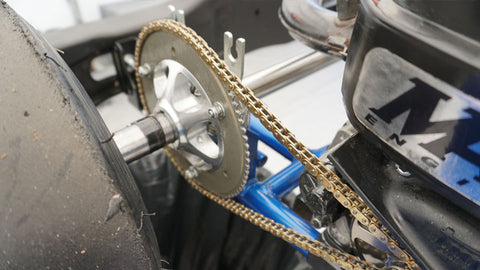As you continue to race and progress in your racing career, your go-kart will naturally incur some wear and tear. This can’t be avoided and must be addressed sooner or later, otherwise the performance of your kart will deteriorate over time, and you will find yourself with more mechanical failures. With that in mind, here are some things to keep in mind when it comes to go-kart maintenance.
Brakes

The brake system from a Praga Go-Kart
To check brake performance, you can check your brake fluid as this can either run out or go bad. A sign of low brake fluid is if the kart takes longer to stop than usual, or if you hear any excessive squeaking of the brakes. Another thing you can do is bleed your brakes. Bleeding your brakes means to remove all air pressure from the brake lines which can help fill them with brake fluid, which improves braking performance. It’s wise to keep an eye on your brake pad depth also, as over time these wear out and will drastically halt your braking performance.
Nuts and bolts

A toolbox with many types of spanners and wrenches
One loose nut can end your day. With so many nuts and bolts, it is important to check every single one of them is tight and secured. Prepare a tool kit containing spanners and wrenches of all shapes and sizes as there are many kinds of nuts and bolts on a go-kart. Floor tray bolts, and rear crash bar bolts are two that spring to mind that loosen over time easiest. Chain guard bolts, and brake carrier bolts are often forgotten about when making rear end adjustments.
Exhaust

Rust slowly builds up in the exhaust, which can affect the efficiency of the engine. Therefore, always make sure to clean your exhaust with a lubricant. One of the most frequently used lubricants out there is the WD-40. Start by detaching the exhaust from the go-kart. Then, make the exhaust stand upright. From there, you will get a rag and apply the lubricant and begin wiping. Once the rust is removed you can attach the exhaust onto the engine once again. Restricted classes might find their exhaust pipes start to clog up the end pipe. Once the small opening hole begins to get more carbon build up, this can reduce engine performance as it acts as a second restrictor.
Chassis

Kart Republic KR2 Chassis
Be sure to check the body/chassis itself for any cracks or scratches in it. if there are a lot, it is a sign that the kart is beginning to show its age. Be sure to check the tie rods if they are rusty or bent in the worst case. Hold the tires and move them from left to right as that part should feel tight. If not, and they feel loose, it could be that the bearings are beginning to deteriorate. If you notice your kart bottoming out on the race track a lot, check the waist of the kart as this will start to flatten out potentially over time.
Mychron

Aim Mychron 5, the latest model
Your Mychron is the most important data tracking device in your kart as it tracks everything from your lap time to your speeds. Just like with your everyday devices, these things run out of battery. Therefore, it is important to charge them when they are not in use so that they do not run out of battery when you are on track and you can gain valuable data.
Chain and sprocket

This part of the go-kart needs the most maintenance as the general wear and tear here is high. It is one of the most important parts of the go-kart as this transfers energy from the engine. If you notice your chain is becoming very loose in sections, this could be the chain has stretched. Once stretched, it will start to wear your sprocket quicker and then reliability issues can happen. To clean, start by removing the wheels and clamps that are attached to the engine for the chain to come loose. Before cleaning the chain, check if it’s links contain any damage. If so, this may be a sign that you must replace the chain completely. If not, the next step is to soak the chain in petrol as this can remove any dirt and rust that has built up over time. The next thing to clean is the sprocket. All you need is a rag to start wiping the sprocket and rid of any dirt. Now that the parts are clean, attach the chain once more, tighten the engine clamps and reattach the wheels, and the kart is good to go.
Fuel System




From left to right: Fuel Tank, Tillotson Carburetor, Fuel Line, Fuel Filter
The fuel system of a tank consists of the fuel tank, line, filter, and carburetor, all of which need maintenance. For the carburetor, make sure to remove and completely drain all the fuel inside as leaving fuel inside the carburetor for a long period of time makes it difficult to clean. A fuel filter can be cleaned with a good spray of carburetor cleaner. For the fuel line, it does not usually need to be cleaned as you will see yourself replacing them instead of cleaning them once they get old. Once the fuel line becomes hard and possibly discolored this is a sign it’s old.
That concludes our blog on things you must do to take care of your go-kart and maintain its performance. These are some of the basics of maintenance, and you will certainly learn more about maintaining your kart as you progress through your career. To help with this, Kart Class has a Kart Setup Program to help you expand further on your mechanical knowledge of a go-kart.
